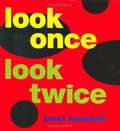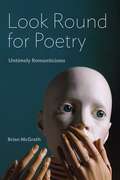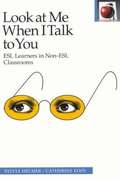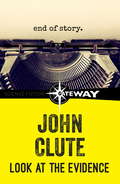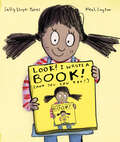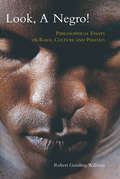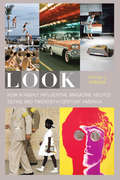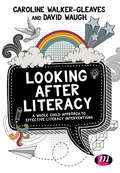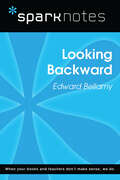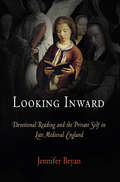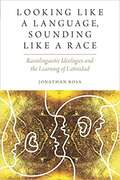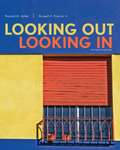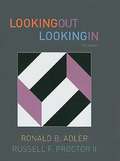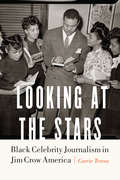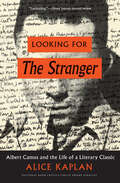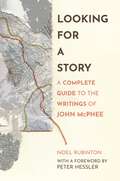- Table View
- List View
Look Homeward: A Life Of Thomas Wolfe
by David Herbert DonaldThomas Wolfe, one of the giants of twentieth-century American fiction, is also one of the most misunderstood of our major novelists. A man massive in his size, his passions, and his gifts, Wolfe has long been considered something of an unconscious genius, whose undisciplined flow of prose was shaped into novels by his editor, the celebrated Maxwell Perkins.<P><P> Pulitzer Prize Winner
Look Once, Look Twice
by Janet MarshallIn this unique and playful picture book, the striking patterns found on animals, plants, and other natural forms are used to create each letter of the alphabet. Readers must guess what each pattern comes from. On the right-hand page is the clue: the letter. On the left-hand page is the answer. The clues can be as obvious as a zebra-striped z and a rainbow r, or as subtle and surprising as an m-shaped close-up of a macaw's wing. With vibrant, graphic cut-paper illustrations, Janet Marshall has created a vivid reminder that even the simplest things around us are worth a second look.
Look Out! (Reach Into Phonics Ser.)
by Deborah J. Short Joanna Korba Willa JimmersonNIMAC-sourced textbook
Look Round for Poetry: Untimely Romanticisms (Lit Z)
by Brian McGrathPoetry is dead. Poetry is all around us. Both are trite truisms that this book exploits and challenges.In his 1798 Advertisement to Lyrical Ballads, William Wordsworth anticipates that readers accustomed to the poetic norms of the day might not recognize his experiments as poems and might signal their awkward confusion upon opening the book by looking round for poetry, as if seeking it elsewhere. Look Round for Poetry transforms Wordsworth’s idiomatic expression into a methodological charge. By placing tropes and figures common to Romantic and Post-Romantic poems in conjunction with contemporary economic, technological, and political discourse, Look Round for Poetry identifies poetry’s untimely echoes in discourses not always read as poetry or not always read poetically.Once one begins looking round for poetry, McGrath insists, one might discover it in some surprising contexts. In chapters that spring from poems by Wordsworth, Lucille Clifton, John Keats, and Percy Bysshe Shelley, McGrath reads poetic examples of understatement alongside market demands for more; the downturned brow as a figure for economic catastrophe; Romantic cloud metaphors alongside the rhetoric of cloud computing; the election of the dead as a poetical, and not just a political, act; and poetic investigations into the power of prepositions as theories of political assembly.For poetry to retain a vital power, McGrath argues, we need to become ignorant of what we think we mean by it. In the process we may discover critical vocabularies that engage the complexity of social life all around us.
Look at Me When I Talk to You: ESL Learners in Non-ESL Classrooms (2nd edition)
by Sylvia Helmer Catherine L. EddyThis book explores the underlying fundamentals of communication to show how culture influences the messages sent and received. Elements of both the theory and practice of communicating in a multicultural setting are discussed, and examples from real classrooms illustrate the issues that can, and do, arise. Practical suggestions provided in this book help all teachers working with students who are learning English as an additional language.
Look at the Evidence
by John CluteFor more than 50 years John Clute has been reviewing science fiction and fantasy. Look at the Evidence is a collection of reviews from a wide variety of sources - including Interzone, the New York Review of Science Fiction, and Science Fiction Weekly - about the most significant literatures of the twenty-first century: science fiction, fantasy and horror: the literatures Clute argues should be recognized as the central modes of fantastika in our times. It covers the period between 1987 and 1992.
Look at the Evidence
by John CluteFor nearly 40 years John Clute has been reviewing science fiction and fantasy. Look at the Evidence is a collection of reviews from a wide variety of sources - including Interzone, the New York Review of Science Fiction, and Science Fiction Weekly - about the most significant literatures of the twenty-first century: science fiction, fantasy and horror: the literatures Clute argues should be recognized as the central modes of fantastika in our times. It covers the period between 1987 and 1992.
Look! I Wrote a Book! (And You Can Too!)
by Sally Lloyd-JonesFrom a New York Times bestselling author and an award-winning illustrator comes an utterly hilarious step-by-step guide to writing a book, as told by a child "author."Want to write a book? Well, the spunky, know-it-all narrator of this side-splitting story can tell you just how to do it. She walks readers through the whole process, from deciding what to write about (like dump trucks or The Olden Days) to writing a story that doesn't put everyone to sleep and getting people to buy your book (tips: be nice, give them cookies, and if all else fails, tie them to a chair). Packed with bestselling author Lloyd-Jones's signature wit and charm, this picture book, with whimsical illustrations by beloved illustrator Layton, delivers an outrageously silly story that is sure to have young readers--and writers!--howling with laughter.
Look, a Negro!: Philosophical Essays on Race, Culture, and Politics
by Robert Gooding-WilliamsFirst published in 2006. Routledge is an imprint of Taylor & Francis, an informa company.
Look: How a Highly Influential Magazine Helped Define Mid-Twentieth-Century America
by Andrew L. YarrowAndrew L. Yarrow tells the story of Look magazine, one of the greatest mass-circulation publications in American history, and the very different United States in which it existed. The all-but-forgotten magazine had an extraordinary influence on mid-twentieth-century America, not only by telling powerful, thoughtful stories and printing outstanding photographs but also by helping to create a national conversation around a common set of ideas and ideals. Yarrow describes how the magazine covered the United States and the world, telling stories of people and trends, injustices and triumphs, and included essays by prominent Americans such as Martin Luther King Jr. and Margaret Mead. It did not shy away from exposing the country&’s problems, but it always believed that those problems could be solved.Look, which was published from 1937 to 1971 and had about 35 million readers at its peak, was an astute observer with a distinctive take on one of the greatest eras in U.S. history—from winning World War II and building immense, increasingly inclusive prosperity to celebrating grand achievements and advancing the rights of Black and female citizens. Because the magazine shaped Americans&’ beliefs while guiding the country through a period of profound social and cultural change, this is also a story about how a long-gone form of journalism helped make America better and assured readers it could be better still.
Looking After Literacy: A Whole Child Approach to Effective Literacy Interventions
by David Waugh Caroline Walker-GleavesThis book is about supporting all children to overcome their individual challenges to literacy. It is about considering the whole child when exploring options for interventions and accepting that many children have more than one need. It examines the many factors that can contribute to literacy difficulties and highlights the importance of understanding the wider context when considering them. The text draws on the latest research in education, psychology , neurology and sociology to illustrate how children's literacy development can be mapped against difficulties in other areas of their lives. This is a ground-breaking and accessible book for all trainee and existing primary teachers working with young children who are experiencing difficulty with reading, written and spoken language.
Looking After Literacy: A Whole Child Approach to Effective Literacy Interventions
by David Waugh Caroline Walker-GleavesThis book is about supporting all children to overcome their individual challenges to literacy. It is about considering the whole child when exploring options for interventions and accepting that many children have more than one need. It examines the many factors that can contribute to literacy difficulties and highlights the importance of understanding the wider context when considering them. The text draws on the latest research in education, psychology , neurology and sociology to illustrate how children's literacy development can be mapped against difficulties in other areas of their lives. This is a ground-breaking and accessible book for all trainee and existing primary teachers working with young children who are experiencing difficulty with reading, written and spoken language.
Looking Backward (SparkNotes Literature Guide Series)
by SparkNotesLooking Backward (SparkNotes Literature Guide) by Edward Bellamy Making the reading experience fun! Created by Harvard students for students everywhere, SparkNotes is a new breed of study guide: smarter, better, faster. Geared to what today's students need to know, SparkNotes provides: *Chapter-by-chapter analysis *Explanations of key themes, motifs, and symbols *A review quiz and essay topicsLively and accessible, these guides are perfect for late-night studying and writing papers
Looking For Palestine: Growing Up Confused In An Arab-American Family
by Najla SaidThe daughter of a prominent Palestinian father and a sophisticated Lebanese mother, Majla Said grew up in New York City, confused and conflicted about her cultural background and identity. But while her father and brother shared a passion for debate about the politics of the Middle East and her mother held on deeply to her Lebanese roots, Said was satisfied to be her father's darling daughter, content with her life on Manhattan's Upper West Side. Her home life was rich and embracing, but outside her apartment she felt entirely unsure about who she was supposed to be, and often in denial of the differences she sensed between her family and those around her. She may have been born a Palestinian Lebanese American, but in her own mind she grew up first as a WASP (baptized Episcopalian in Boston; attending Chapin, the wealthy Upper East Side girls' school), then as a teenage Jew, essentially denying her true roots, even to herself, until well into adulthood. The fact that her father was Edward Said - the famous intellectual, founding father of postcolonial thought, and outspoken advocate for the political and human rights of the Palestinian people - only made things more complicated. Said knew that her parents identified deeply with the countries they had come from, but growing up in a Manhattan world that was defined largely by class and confirmity, where she felt her family was a cultural island all its own, she sought comfort by fitting in with their peers, until, ultimately, the psychological toll of her self-hatred began to threaten her health. As she grew older, and made increased visits to Palestine and Beirut, Said's worldview shifted. The attacks on the World Trade Center, and some of the ways in which Americans responded, finally made it impossible for her to continue to pick and choose her identity, and allowed her to see herself and her passions more clearly. In Looking for Palestine, she shares the journey to this understanding and the experience of growing up in an immigrant family and learning to embrace its cultures. Praise for Looking for Palestine 'Najla Said's Looking for Palestine is a compassionate and candid book on her courageous coming-of-age in contemporary America. Said is a brilliant, talented, and sensitive artist with a larger-than-life, loving father. ' Professor Cornel West' A deeply penetrating, often hilarious, and occasionally devastating account of growing up Arab-American. After finally finding the conviction to be at peace with herself, Najla Said has written more than a memoir. Looking for Palestine is a survivor's guide for all of us who live with that feeling of being out of place wherever we are. ' Moustafa Bayoumi, author of How Does It Feel to Be a Problem? Being Young and Arab in America' thoughtful, searching, and open-eyed, Looking for Palestine takes readers on a journey into an Arab-American girl's search for identity . . . A haunting and singular life story. ' Diana Abu-Jaber, author of Crescent' It can be a difficult story to tell: that of one's discontent in the midst of privilege. And yet with great skill, humor, and poignancy, Said accomplishes just that. In the end, she is her late father's great inheritor, ever journeying toward that elusive home.
Looking Into Providences
by Raymond WaddingtonWhat is the role of providence in Paradise Lost? In Looking into Providences, Raymond B. Waddington provides the first examination of this engaging subject. He explores the variety of implicit organizational structures or 'designs' that govern Paradise Lost, and looks in-depth at the 'trials,' or testing situations, which require interpretation, choice, and action from its characters.Waddington situates the poem within the context of providentialism's centrality to seventeenth-century thought and life, arguing that Milton's own conception of providence was deeply influenced by the theology of Jacob Arminius. Using Milton's Arminian conception of free will, he then looks at the providential trials experienced by angels and humans. Finally, the work explores the ways in which providentialism infiltrates various kinds of discourse, ranging from military to medical, and from political to philosophical.
Looking Inward
by Jennifer Bryan"You must see yourself." The exhortation was increasingly familiar to English men and women in the two centuries before the Reformation. They encountered it repeatedly in their devotional books, the popular guides to spiritual self-improvement that were reaching an ever-growing readership at the end of the Middle Ages. But what did it mean to see oneself? What was the nature of the self to be envisioned, and what eyes and mirrors were needed to see and know it properly?Looking Inward traces a complex network of answers to such questions, exploring how English readers between 1350 and 1550 learned to envision, examine, and change themselves in the mirrors of devotional literature. By all accounts, it was the most popular literature of the period. With literacy on the rise, an outpouring of translations and adaptations flowed across traditional boundaries between religious and lay, and between female and male, audiences. As forms of piety changed, as social categories became increasingly porous, and as the heart became an increasingly privileged and contested location, the growth of devotional reading created a crucial arena for the making of literate subjectivities. The models of private reading and self-reflection constructed therein would have important implications, not only for English spirituality, but for social, political, and poetic identities, up to the Reformation and beyond.In Looking Inward, Bryan examines a wide range of devotional and secular texts, from works by Walter Hilton, Julian of Norwich, and Thomas Hoccleve to neglected translations like The Chastising of God's Children and The Pricking of Love. She explores the models of identification and imitation through which they sought to reach the inmost selves of their readers, and the scripts for spiritual desire that they offered for the cultivation of the heart. Illuminating the psychological paradigms at the heart of the genre, Bryan provides fresh insights into how late medieval men and women sought to know, labor in, and profit themselves by means of books.
Looking Like a Language, Sounding Like a Race: Raciolinguistic Ideologies and the Learning of Latinidad (Oxford Studies in Anthropology of Language Series)
by Jonathan RosaLooking like a Language, Sounding like a Race examines the emergence of linguistic and ethnoracial categories in the context of Latinidad. <p><p>The book draws from more than twenty-four months of ethnographic and sociolinguistic fieldwork in a Chicago public school, whose student body is more than 90% Mexican and Puerto Rican, to analyze the racialization of language and its relationship to issues of power and national identity. It focuses specifically on youth socialization to U.S. Latinidad as a contemporary site of political anxiety, raciolinguistic transformation, and urban inequity. <p><p> Jonathan Rosa's account studies the fashioning of Latinidad in Chicago's highly segregated Near Northwest Side; he links public discourse concerning the rising prominence of U.S. Latinidad to the institutional management and experience of raciolinguistic identities there. <p><p>Anxieties surrounding Latinx identities push administrators to transform "at risk" Mexican and Puerto Rican students into "young Latino professionals." This institutional effort, which requires students to learn to be and, importantly, sound like themselves in highly studied ways, reveals administrators' attempts to navigate a precarious urban terrain in a city grappling with some of the nation's highest youth homicide, dropout, and teen pregnancy rates. Rosa explores the ingenuity of his research participants' responses to these forms of marginalization through the contestation of political, ethnoracial, and linguistic borders.
Looking Out Looking In
by Ronald B. Adler Russell F. Proctor IIThe Fifteenth Edition includes an all-new Chapter 2 devoted to interpersonal communication and social media, while coverage of mediated communication is also integrated throughout. In addition, diverse examples, engaging readings, compelling cartoons, vibrant photos, and popular culture references bring chapter concepts to life.
Looking Out, Looking In (13th Edition)
by Ronald B. Adler Russell F. ProctorUsed by more than a million students, LOOKING OUT/LOOKING IN, Thirteenth Edition, continues its outstanding tradition of combining current information with a fun, reader-friendly voice that links course topics to your everyday life. You'll discover the reasons to improve your interpersonal skills and sharpen your critical understanding of the communication process through diverse and compelling examples that illustrate how communication skills can affect both the world around us and our own lives. Improve your relationships and your future career success with this engaging text that teaches interpersonal concepts through popular music, art, movies, and television.
Looking at the Stars: Black Celebrity Journalism in Jim Crow America
by Carrie TeresaAs early as 1900, when moving-picture and recording technologies began to bolster entertainment-based leisure markets, journalists catapulted entertainers to godlike status, heralding their achievements as paragons of American self-determination. Not surprisingly, mainstream newspapers failed to cover black entertainers, whose “inherent inferiority” precluded them from achieving such high cultural status. Yet those same celebrities came alive in the pages of black press publications written by and for members of urban black communities. In Looking at the Stars Carrie Teresa explores the meaning of celebrity as expressed by black journalists writing against the backdrop of Jim Crow–era segregation. Teresa argues that journalists and editors working for these black-centered publications, rather than simply mimicking the reporting conventions of mainstream journalism, instead framed celebrities as collective representations of the race who were then used to symbolize the cultural value of artistic expression influenced by the black diaspora and to promote political activism through entertainment. The social conscience that many contemporary entertainers of color exhibit today arguably derives from the way black press journalists once conceptualized the symbolic role of “celebrity” as a tool in the fight against segregation. Based on a discourse analysis of the entertainment content of the period’s most widely read black press newspapers, Looking at the Stars takes into account both the institutional perspectives and the discursive strategies used in the selection and framing of black celebrities in the context of Jim Crowism.
Looking for Other Worlds: Black Feminism and Haitian Fiction (New World Studies)
by Régine Michelle Jean-CharlesWhat would it mean to reorient the study of Haitian literature toward ethics rather than the themes of politics, engagement, disaster, or catastrophe? Looking for Other Worlds engages with this question from a distinct feminist perspective and, in the process, discovers a revelatory lens through which we can productively read the work of contemporary Haitian writers.Régine Michelle Jean-Charles explores the "ethical imagination" of three contemporary Haitian authors—Yanick Lahens, Kettly Mars, and Evelyne Trouillot—contending that ethics and aesthetics operate in relation to each other through the writers’ respective novels and that the turn to ethics has proven essential in the twenty-first century. Jean-Charles presents a useful framework for analyzing contemporary literature that brings together Black feminism, literary ethics, and Haitian studies in a groundbreaking way.
Looking for The Stranger: Albert Camus and the Life of a Literary Classic
by Alice KaplanA New York Times Notable Book. A literary exploration that is &“surely destined to become the quintessential companion to Camus&’s most enduring novel&” (PopMatters). The Stranger is a rite of passage for readers around the world. Since its publication in France in 1942, Camus&’s novel has been translated into sixty languages and sold more than six million copies. It&’s the rare novel that&’s as likely to be found in a teen&’s backpack as in a graduate philosophy seminar. If the twentieth century produced a novel that could be called ubiquitous, The Stranger is it. How did a young man in his twenties who had never written a novel turn out a masterpiece that still grips readers more than seventy years later? With Looking for The Stranger, Alice Kaplan tells that story. In the process, she reveals Camus&’ achievement to have been even more impressive—and more unlikely—than even his most devoted readers knew. &“To this new project, Kaplan brings equally honed skills as a historian, literary critic, and biographer . . . Reading The Stranger is a bracing but somewhat bloodless experience. Ms. Kaplan has hung warm flesh on its steely bones.&” —The New York Times &“For American readers, few French novels are better known, and few scholars are better qualified than Kaplan to reintroduce us to it . . . Kaplan tells this story with great verve and insight, all the while preserving the mystery of its creation and elusiveness of its meaning.&” —Los Angeles Review of Books &“The fascinating story behind Albert Camus&’ coldblooded masterpiece . . . A compelling companion to a novel that has stayed strange.&” —Kirkus Reviews
Looking for a Story: A Complete Guide to the Writings of John McPhee
by Noel RubintonAn annotated guide to the work of the Pulitzer Prize–winning writer, teacher, and pioneer of creative nonfictionJohn McPhee has been a staff writer for The New Yorker since 1965 and has written more than thirty acclaimed books that began on the magazine&’s pages. But few readers know or fully appreciate the true breadth of his writing. Looking for a Story is a complete reader&’s guide to McPhee&’s vast published work, documenting much rarely seen or connected with McPhee, including remarkable early writing for Time magazine published without his name.In chronicling McPhee&’s career where he broke ground applying devices long associated with fiction to the literature of fact, Noel Rubinton gives insights into McPhee&’s techniques, choice of subjects, and research methods, shedding light on how McPhee turns complicated subjects like geology into compelling stories. Beyond detailing more than seventy years of McPhee&’s writing, Rubinton recounts McPhee&’s half century as a Princeton University writing professor, a little known part of his legacy. McPhee inspired generations of students who wrote hundreds of books of their own, also catalogued here.With an incisive foreword by New Yorker staff writer and former McPhee student Peter Hessler, Looking for a Story also includes extensive annotated listings of articles about McPhee, reviews of his books, and interviews, readings, and speeches. Whether you are already an admirer of McPhee or new to his writings, this book provides an invaluable road map to his rich body of work.

